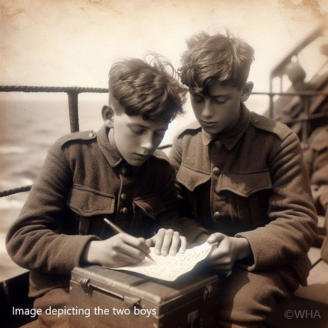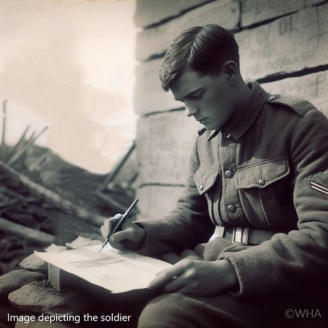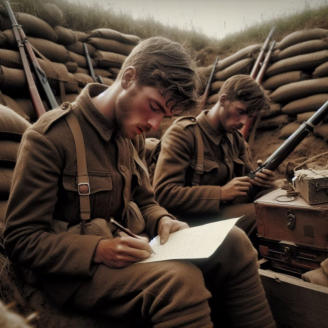copyright © Wartime Heritage Association 2012 - 2024
Website hosting courtesy of Register.com - a web.com company
Wartime Heritage
ASSOCIATION
Selected Stories of WWI from Wartime Heritage
A Selection of Wartime Heritage Stories
Somewhere in the Atlantic
Alfred was seventeen when he enlisted with the 115th Battalion. His brother Jimmy was fourteen when he enlisted with the 112th Battalion. Although in different Battalions the two brothers were on the RMS Olympic in July 1916 and found one another among the 4000 soldiers that roamed the decks. The day before the Olympic arrived in Liverpool, England, the two met and together wrote letters home. They concocted little notes and traced the outline of their Battalion badges and signed the paper with their name and Battalion number. Enclosed with the letter together with several other sheets was: “Somewhere in the Atlantic Ocean on the troopship. Fine weather and a very pleasant journey. Saturday, July 29, 1916. Pte. A. J. Muise and Pte. J W. Muise both serving in the King’s army - H.R.M. King George V.” Alfred served with the 25th Battalion in France and was killed in action on April 29, 1917. James (Jimmy) served with the Royal Canadian Regiment and was gassed at Passchendaele and invalided to Canada in 1918. Read their full story at: http://wartimeheritage.com/storyarchive1/story_ somewhere_in_the_atlantic.htm
Remembering My Brother
A faded drawing created in November 1917 by Corporal John Arthur Muise lies with a few treasured family keepsakes of World War I. Four brothers from the Muise family of Yarmouth, Nova Scotia would serve their country, Alfred, James (Jimmy), George Stanley, and John Arthur. Alfred, age 18, was killed in action on April 29, 1917, and his brother created the drawing that depicted a cross with his younger brother’s name. A date at the bottom of the drawing suggests Arthur would have been near Ypres where his Battalion was preparing for the assault at Passchendaele. The deaths and injuries were horrific, and one can imagine a brother sitting quietly and pondering an earlier tragedy of death and the loss of a younger brother. The background in his drawing is prophetic as there appears in the distance a tower that resembles the Vimy Memorial. And yet, at that time the Memorial did not exist. Read the full story at: http://wartimeheritage.com/storyarchive1/story_ remembering_my_brother.htm
My Best and Only Chum
The reality of wartime events a hundred and more year’s past may fade but a letter written in 1915 provides a profound reminder of tragedy and sadness that occurred on the battlefields of World War I. Raymond Saunders of Hebron, Yarmouth Co., Nova Scotia enlisted at the age of 16. He served as a Gunner/Driver of an artillery piece drawn by four horses. During the Battle of St. Julian, he was severely wounded on April 24 and died from wounds on April 25, 1915. A letter from Colin Campbell of Weymouth, Nova Scotia, to Raymond’s father would provide the details of Raymond’s injury and death. “He had a shroud and coffin and was buried in the cemetery of that town. Although we had quite a time to get a cross to mark his resting place, we found a wheeler’s shop and I made a nice one myself on which I painted his name, date of birth and birthplace. With me was Gunner O.B. McNeil, of Hebron, NS and Gunner Charles Emin of Yarmouth. We had prayers over his resting place and made arrangements to have it put in as nice shape as possible.” Read the full story and letter at: http://wartimeheritage.com/whawwi/whawwi_sau nders_raymond.htm
Image depicting the soldier
Waiting Until the Darkness
Tom was serving as a stretcher bearer with the 24th
Battalion. “Bullets were flying like hail and their big
guns were doing their best to stop us” as the soldiers
moved against the enemy trenches in early October
1916.
“We rushed to their first line, soon took that … then
we made for the second line and here is where we
lost the most of our men … What was left of us took
the trench … I started to do a bit of doctoring. I had
tied up four or five fellows and was on my way over
to another one when bang! my leg gave way, and I
dropped in a shell hole. I cut my pant-leg off and
found that the bullet had gone trough my thigh about
five inches above the knee. I fixed myself up and
waited for darkness. Then I started crawling out. It
was two miles and a half to the dressing station, and
they were shelling pretty heavy all the way, but I got
out with only a scratch or two from them.”
Tom Smith recovered from his wound and returned to
the 24th Battalion. One year later he was tending to a
wounded soldier when an artillery shell exploded on
them, and both were killed instantly.
Tom’s friend Willard Perry who also served with the
24th Battalion wrote: “I was out on a wiring party
between our lines and Fritz’s front when I first heard
the news the following night and it was an awful
shock to me. Every spare minute we had to ourselves
Tom and I were together, and we always shared with
each other. I had a box from home on Tuesday. I
thought of Tom when I was opening it and I had to
just sit down and cry. God be with him ‘till we meet
again is my prayer.”
Willard Perry was hit by a piece of shrapnel and
instantly killed on November 6, 1917.

Image depicting the soldier
Thomas Smith and Willard Perry were from Yarmouth
Co., in Nova Scotia. Thomas Smith’s name is listed on
the Yarmouth Memorial, Willard Perry name is not
listed. Read their Remembrance pages and letters:
Thomas Smith and Willard Perry
© WHA
© WHA















